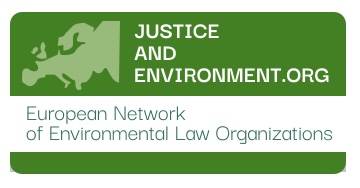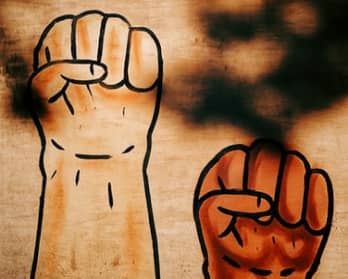New J&E study illuminates how human, social and environmental rights and legal definitions have evolved to shape a new concept – that of climate rights
A new study by the international network of environmental lawyers Justice and Environment (J&E) shows that a new concept – that of climate rights – is emerging globally. The concept was applied by the J&E network of 15 environmental law оrganisations to capture a variety of rights and legal mechanisms – both existing and newly emerging ones – that relate to climate change.
The study was undertaken as part of J&E’s project “Discussions and Actions on Climate and Environment”. The project’s purpose is to raise people’s awareness of climate rights and climate change adaptation measures. The initiative spans 6 EU countries. It is funded by the European Union and coordinated by J&E.
The authors of the study delve into the evolving landscape of human, environmental, social, procedural and other rights at international, EU and national level to illuminate how legal definitions have expanded in the past decades to shape the concept of “climate rights”.
For example, the right to life and dignity could now be extended to the right to a clean and healthy environment capable of sustaining quality life; the right not to be deprived of life, liberty or property could be extended to the right to a stable climate; and government duties could be extended to the duty to protect the atmosphere from climate change.
Thus, climate change litigation is leading to an evolution of rights-based litigation across the world because claims made in one jurisdiction are being adapted and applied in other jurisdictions, the study finds.
“The concept of climate rights is overarching and can help create broad coalitions of like-minded individuals because a host of human rights are negatively affected by climate change. This is why we hope we will help different groups of people – climate activists, women’s rights advocates, local communities affected by problems like industrial pollution, health professionals – see that they are essentially fighting the same battle – the battle for climate rights,” said J&E coordinator dr. Csaba Kiss.
“An illustration of the potential of the new concept to connect different stakeholders is that the Bulgarian lawyers who won a case against Sofia Municipality for its failure to implement clean air policies did not initially see their battle as a climate battle. Our study demonstrated that it was – firstly, because the sectors of the economy that cause air pollution and climate change largely overlap (even though air pollutants and greenhouse gasses may not be the same). Transport, energy production and agriculture are responsible for 70-80% of greenhouse gas emissions. Simultaneously, they are the main source of air pollution. Secondly, there are studies that demonstrate the two-fold connection between clean air and climate change –air pollution increases the impacts of climate change,” said environmental lawyer Plamen Peev.
By far the most prevalent climate litigation cases are those that challenge the legality, applicability or (lack of) enforcement of national laws or policies that outline the climate obligations of public and private actors. This means that most climate cases are naturally brought against governments, but recent years have seen a rise in cases against corporations as well.
“Having in mind that 100 enterprises are responsible for about 70% of global emissions, this is an understandable development,” says environmental lawyer and policy expert Veronika Marhold. “These cases may become even more common than climate rights cases that cite fundamental human rights, but their impact will depend on the scope of remedies courts award.” Marhold says.
Most cases against corporations are based on tort law (nuisance, negligence, strict liability and civil conspiracy). Other claims are based on the argument of unjust enrichment and consumer protection law. Yet a third set of claims is brought by shareholders. Shareholders typically argue that poor knowledge of climate risks prevents them from exercising their rights as shareholders or that the company’s misleading information has harmed their interests as shareholders.
One example of a shareholder case is the one of the City of Birmingham Retirement and Relief System vs. Tillerson. Stockholders filed a suit against Exxon claiming that the company had misled stockholders about climate-related risks to its business. The plaintiffs allege both that Exxon knew but failed to disclose the “catastrophic risk that climate change presents to its business,” and that the company actively engaged in a misinformation campaign to muddy its own scientists’ conclusions about climate change.
The study outlines the J&E team’s assessment framework for climate rights (Chapter II), reviews the main types of climate rights and legal mechanisms (Chapter III), presents the trends in climate change litigation (Chapter IV), and finally, provides some country cases of climate rights from Austria, Bulgaria and Spain (Chapter V).
Below is a brief summary of the team’s analytical approach and findings.
Assessment framework for climate rights
The team used 4 levels of analysis to identify climate rights:
1. How is the specific right affected by climate change? How does defending this right affect/change climate policies?
2. Does the case concern substantive or procedural rights? (examples of substantive rights are the right to life, health, property, etc.; examples of procedural rights are the legal mechanisms and procedures that help people and organisations pursue their substantive rights, like the ombudsman institution, the right to express your opinion during a public consultation process, access to information and justice, the e-portals for sending signals to institutions about corruption or law infringement, etc.)
3. Does the legal case protect collective rights or individual rights (is the case led in the name of groups of people or is the plaintiff an individual?)
4. Is the case brought before a national or an international court?
The study identified 6 types of climate rights and obligations
1. Fundamental human/constitutional rights (the right to life, property, health, etc.)
Example: Pavlov and others vs Russia, 2009
Complaint under Article 8 of the European Convention on Human Rights
14 government agencies in Lipetsk were taken to court by citizens who alleged that the authorities failed to regulate industrial air pollution. Local courts rejected the claim. The citizens then brought their complaint to the ECtHR, citing violations of Article 8 of the Convention. The Court found that the authorities had failed to protect the citizens from the health risks of industrial air pollution, as they did not enforce regulations or adopt appropriate measures to prevent or sufficiently reduce pollution hazards.
2. Climate-related social rights (like the right of workers in coal plants to well-paid low-carbon jobs that ensure a just transition for them and their families)
Example: In Ricardo Castillo Arancibia vs. the Municipality of Monte Patria (proceedings took place before the Supreme Court of Chile) the plaintiff’s working contract was terminated (“not renewed”) in December 2021 and he argued that he had been dismissed for political reasons and due to a discriminatory act by the defendant. The municipality on the other hand stated that the termination of the contract was due to a restructuring of the Department of the Environment to address extreme drought and to favour sustainable use of water, which required different planning than the plaintiff had done previously. The plaintiff maintained that the climate crisis had been around for 20 years and that his work focused specifically on water resource optimization, weakening the argument of the municipality. After the claim was rejected by the District Court and the Court of Appeals, it is now pending before the Supreme Court of Chile. The proceedings set an example for the question whether climate change’s impact on the environment provide legal justification for the termination of an employment contract and whether public institutions can be requested to take adaptation measures such as retraining to soften the blow of the changes in the labour market.
3. The obligation of countries to meet international climate targets
Example: In PUSH Sweden, Nature and Youth Sweden and Others v. the Government of Sweden, the plaintiffs claimed that Sweden’s response to climate change did not align with international commitments. However, the court denied this claim as the plaintiffs were not personally affected by the policies.
4. Corporate social responsibility and liability
Example: Peruvian farmer Saúl Luciano Lliuya filed a letter of complaint against RWE, a German energy company over the impact of its activities on climate change. He argued that his home in Huaraz, on the flood path of Palcacocha Lake, was threatened by the imminent collapse of two glaciers as an effect of global warming. If the glaciers collapsed into the lake, this would cause major flooding. The farmer accused RWE as a major emitter of greenhouse gases, which are causing glacial retreat, which also increased the risk of flooding in the area around the lake. The claimant demanded RWE to pay £14,250 in damages for its contribution to global warming. This amounts to 0.47% of the estimated repair cost in case of flooding since research estimates that RWE is responsible for 0.47% of global warming emissions from 1751 to 2010. The compensation would be invested in prevention measurements against flooding in the area.
RWE rejected the plaintiff’s letter of complaint maintaining that the claims lack a legal basis and the company is therefore not responsible. As a consequence, Lliuya filed a lawsuit against RWE in a German court. It was, however, dismissed because the judge found that the plaintiff had not established that RWE was legally responsible for protecting Huaraz from flooding. The farmer consequently filed an appeal. The case is ongoing.
5. The right to appropriate climate adaptation
Example: In the landmark decision of Daniel Billy and others vs. Australia, the U.N. Human Rights Committee held that Australia is violating its human rights obligations to the indigenous Torres Strait Islanders through climate change inaction. The indigenous group challenged Australia’s lack of mitigation and adaptation measures, and the Committee recognized that climate change has been currently impacting the claimants’ daily lives. It held further that Australia’s poor climate record is a violation of their right to family life and right to culture under the International Covenant on Civil and Political Rights.
6. Procedural rights related to climate change (e.g. the right to participate in decision-making (for example, by taking part in a a public consultation process),- the right to access public information (e.g. accessing information on the way public funding is spent); e-portals for sending signals to institutions about corruption or law infringement)
You can download the full study here: https://justiceandenvironment.org/wp-content/uploads/2023/08/Climate-rights-study_final_web-1.pdf
The initiative Discussions and Actions on Climate and Environment is funded by the European Union and coordinated by J&E in partnership with the International Institute for Law and the Environment (IIDMA, Spain), BlueLink Foundation (Bulgaria), The Alliance of the Austrian Environmental Movement (ÖKOBÜRO, Austria), the Environmental Management and Law Association (EMLA, Hungary), the Legal Center for Human Rights Protection (PIC, Slovenia), and the Estonian Environmental Law Centre (EELC, Estonia).
All views and opinions expressed are the authors’ only and do not necessarily reflect those of the European Union (EU) or of the granting authority – the European Education and Culture Executive Agency (EACEA). Neither the EU nor EACEA can be held responsible for them.


